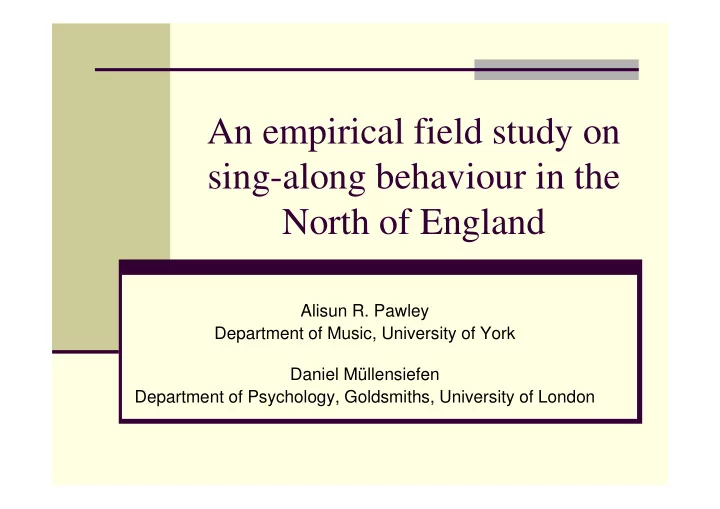

An empirical field study on sing-along behaviour in the North of England Alisun R. Pawley Department of Music, University of York Daniel Müllensiefen Department of Psychology, Goldsmiths, University of London
What do these songs have in common? I’m Always Here Livin’ on a Prayer Chelsea Dagger
Introduction � Strong historical tradition of singing along in England � 20 th century technologies & professionalisation of singer suppress public singing � Singing along in leisure contexts is one of few public music-making opportunities today
Past Research � Social/Cultural Studies: Social bonding , expression of identity , ‘ neo-tribes ’ (Maffesoli, 1988; Finnegan, 1989; Bennett, 1997; Björnberg and Stockfelt, 1996; Malbon, 1999 Jackson, 2004) � Psychology: Positive effects of vocalising (Clift and Hancox, 2001; Freeman, 2001; Unwin, Kenny and Davis, 2002; Kreutz, et al, 2004; Clift, et al, 2007) � Popular Music Analysis: ‘ Singable ’ melodies (Stefani, 1987), structural features of popular anthems (Dockwray, 2005)
Aims � What motivates people to sing along to a song in a leisure context? � Do songs have intrinsic features that make them ‘singalongable’?
Methods: Field Research � Participant observer � Quantitative & qualitative data � 30 nights of research (Nov 2006 - Jul 2007) � 5 venues: Manchester, Leeds, York & Kendal � DJed & live music
Quantitative Results: The Data � Dependent variable: percentage � Contextual variables: of people singing along � Place of song in set � Day of week � Two sets of explanatory � Venue size & function (predictor) variables: contextual � Live vs recorded & musical � Age range of audience � Date of release, UK chart � 1050 ‘song events’ position, weeks in UK chart � 636 different songs � Musical variables (34 total): � 332 song events used in musical � Vocal span & phrase lengths analysis (121 songs) � Vocal hook � Vocal performance � Lyrics � Gender � …
Distribution of Sing-along Percentages (n=1050)
Songs with highest sing-along percentages akin to Dockwray’s (2005) Rock Anthems ‘Top Ten’ Sing-Along Songs Observed Twice or More Song Average % of people Average no. in audience No. of song events singing along when song was played featuring song We are the Champions (Queen) 85.91 85 4 Y.M.C.A. 85 75 2 (Village People) Fat Lip 81.58 80 3 (Sum41) The Final Countdown (Europe) 78.89 70 2 Monster 78.72 70 4 (The Automatic) Rub y 78.52 68.33 3 (Kaiser Chiefs) I’m Always Here 77.18 82.86 7 (Jimi Jameson) Brown Eyed Girl 76.85 86.67 3 (Van Morrison) Teenage Dirtbag (Wheatus) 75.7 68 5 Livin’ on a Prayer 75.36 87 7 (Bon Jovi)
Analysis 1: Contextual Variables � Who sings along at what time and in which context ? � Use statistical regression tree to cope with ‘messy’ data: � Outliers � Non - linear relationships � Violated assumptions of normality and variance homogeneity
Tree Model: Contextual Variables Conditional Inference Regression Tree model: explains ~40% of variance in the data
Analysis 2: Musical Variables � Which musical features motivate sing-along behaviour? � Regression tree with musical variables: R 2 ~ .05 � Maybe no single sing-along formula? � Try different subsets and complex interactions of musical features � Random forest (Breiman, 2001; Strobl et al., 2009) regression: � Build (‘grow’) many tree models on data subsets each with a subset of the explanatory variables � Use majority vote of trees in forest to decide on prediction value for each case � Pro: Much better prediction accuracy than from single tree � Con: No simple rules or individual graphical model but variable importance index
Results � Prediction accuracy: All variables: R 2 = .65 � Contextual variables only: R 2 = .40 � Musical variables only: R 2 = .52 � � Most important variables (importance index): Combined model from contextual variables (101.4) 1. High chest voice (6.8) 2. } Vocal effort (6.4) 3. Aspects of Gender of vocalist (4.9) 4. vocal Clarity of consonants (3.4) 5. performance Vocal melisma and embellishment (3.4) 6. Then: � Compositional structure of melody � Features of lyrics � … �
Relating most important predictors to sing - a l ong percentages (by single trees) Low effort High effort No use of high Use of high chest voice chest voice
Male singer Female singer Duet
Very clear Less clear consonants consonants More vocal Less vocal embellishments embellishments
Summary � Contextual and musical factors determine how many people sing along in leisure contexts (explained variance: ~65%) � Singing along is positively effected by these contextual factors: � Larger venues � Younger people � Weekends � Songs played later in the set � Songs that spent 4 or more weeks in the charts � Singing along is positively influenced mainly by factors relating vocal performance. => It’s the singer not the song!
Implications and Interpretations � Contextual variables that encourage singing along can be connected with general revelry � Familiarity & popularity potentially linked to singing along � No single ‘sing-along’ formula for music � Musical factors that do influence singing along are similar to qualities of anthems in popular music (Dockwray, 2005): � ‘Call to party’ – ‘tribal’ bonding � Expression of excitement of revellers � Word clarity: ease of understanding & reproduction � Singer expresses qualities that inspire confidence � Men don’t like to sing along to women
Next Steps � Validate importance of musical variables for � songs that are currently popular � different social and cultural setting � different musical repertoire � Extract musical features using computational tools � Explore practical applications …? We are very open for collaborations!
What we didn’t find …
Recommend
More recommend